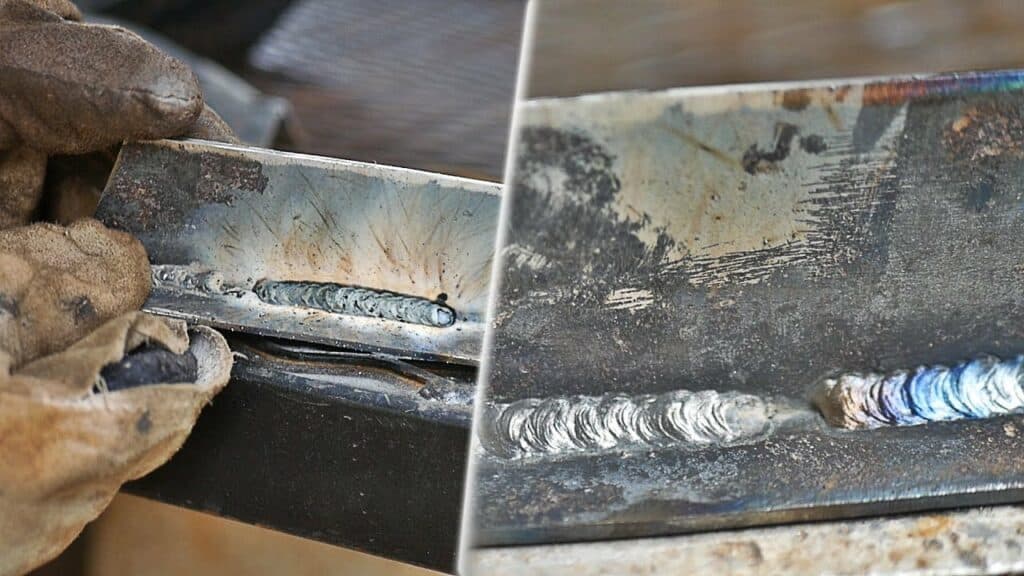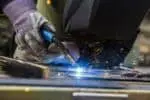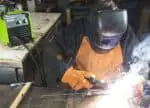MIG (Metal inert gas) welding is one of the most popular welding methods. It creates extremely sturdy and neat joints. Whilst MIG uses inert gas to shield welded joints from contaminants, one of the variations that you might come across is gasless MIG welding.
Out of the two, gasless MIG welding is not the better option since it pollutes the environment at a much larger scale than gas MIG welding does. It doesn’t mean that Gas MIG welding isn’t toxic at all. The truth be told, both types are toxic.
Gas MIG welding is better than gasless because the fumes and smoke are less on compassion with the gasless variation. Then, there’s the cost difference as well. Gasless is costlier than gas MIG welding.
There are many such differences between gas and gasless MIG welding that every welder should know. We’ve touched the cords of gas and gasless MIG welding in this post: the differences, which one is better and why, and much more!
If you’ve been meaning to switch to MIG welding, this guide will clear the air once and for all. So, dive in for all the details.
5 Major Differences Between Gas and Gasless MIG welding
Despite the explanation, the very word gasless MIG welding might create confusion since the very basis of MIG is using an inert gas. But, if you look at the factors closely, gasless MIG welding isn’t really gasless.
The better word for gasless MIG welding is self-shielded MIG welding. Instead of an oxygen cylinder that’s used in gas MIG welding, a flux-core filler is used in the gasless variation.
When the weld starts, the flux-core filler melts. It produces vapors and those vapors protect the weld pool from contaminants, much like the gases do in gas MIG welding.
So, the technique and procedure are the same, but the concept is different. The only reason gasless MIG welding is even called gasless is that it doesn’t use an oxygen cylinder.
Let’s now talk about the differences at length.
#1. The Welding Concept
When you’re using the Gas MIG welding method, the welding rod has to be pushed in order to weld the metal, and the polarity of the machine will always be positive.
In the case of gasless MIG welding, you have to pull the rod to create a drag. The polarity of the machine in gasless MIG will always be negative.
#2. The Toxicity Level
Gasless MIG welding creates substantial amounts of smoke as well as fumes. It’s toxic if inhaled. You’ll always need a very high-quality respirator so that you’re not at the risk of inhaling fumes caused by gasless MIG welding.
In the case of gas MIG welding, fumes and smoke are generated, but they’re a lot less than the gasless version.
#3. The Ease of Use
Unless the piece of metal to be welded is thick and mild steel, gasless MIG welding won’t be that precise. It’s the gas MIG welding option that offers more flexibility. Whether it’s a thin block of metal or any metal, whether it’s a big block or small, gas MIG welding offers precision.
#4. Welding in the Wind
Now, this is where gasless MIG welding steals the cake. When the condition outside is really windy, the gas will blow away, making it very hard to protect the weld pool from contamination.
However, since gasless welding blows vapors precisely directly on top of the weld pool, it’s a much better option than gas MIG welding to prevent contamination.
#5. Ease of Transportability
Again, it’s easier to carry a gasless MIG machine between places because it’s less bulky (it doesn’t have an oxygen cylinder). In other words, gasless MIG welding machines are much more portable than gas MIG welding machines.
Is Gas MIG Welding Better Than Gasless – Are Gas Free Welders Any Good?
You already know the differences between the two at the back of your fingers now. Naturally, it’s gas MIG welding that’s better most of the time. So, does it mean that gas free welders are no good at all? Well, absolutely not!
There are certain scenarios where self-shielding MIG is better than gas MIG welding. The most important considerations to conclude whether the gasless variation is better for you than the gas MIG welding option have been discussed in the upcoming sections.
Where are you welding?
Let’s say, you’re welding indoors, gasless MIG welding can be hazardous for health. The toxic fumes can make you dizzy and constant exposure to the smoke can, later on, lead to degenerative disorders. Hence, you’ve got to be very careful and use the best quality PPE.
Now, reverse the situation – it’s really windy outside! Gasless MIG welding will be a better choice here. Firstly, the smoke and fumes will blow away quickly; hence, you won’t be at the risk of health disorders.
Lastly, since there’s no gas involved directly, the chances of successful welding will be much higher than that in gas welding.
What are you welding?
It’s a known fact that gas MIG welding has a better range in terms of metals it can weld. There’s hardly any metal that gas MIG welding can’t weld. But, if the metal in question is a very thick block of mild steel, gasless MIG welding can be more precise.
The weld is clean and neat. Besides, it can turn out to be cheaper and easier to weld a thick strip of steel using a gasless welder than a gas MIG welder in such a case.
Which of The Two is Better – Gas or Gasless Welding?
Gas MIG welding is better than gasless MIG welding in a lot of ways. It’s less toxic, creates lesser smoke than gasless variation, and can be applied to weld most metals. So, looking at the bigger picture, gasless MIG welding is not a better option than gas MIG welding.
However, if you’re welding outside, gasless MIG welding can be better than gas MIG welding, especially if a thunderstorm is brewing and the conditions are windy.
Pros of Gasless MIG Welding
Just because gas MIG welding is better than gasless MIG welding, it doesn’t mean that gasless MIG welding doesn’t have any pros at all.
You already know the cons of gasless welding by now, in the upcoming section, you’ll be able to explore the pros as well. Let’s have a look!
1.) The weld resulting from gasless MIG is very neat at the end.
2.) Gasless MIG welding is a better option than gas Mig welding if the surface of the metal is rusty or has paint on it.
3.) The vapors are able to eliminate the threat of contamination and oxidation when welding in windy conditions.
FAQs
Can You Weld Thin Metal with a Gasless MIG Welder?
Let’s just say, if the thickness of the metal that’s supposed to be welded is any less than 1.2 mm, it’s better to pass the gasless MIG welding method that uses 0.8 mm wire, and use gas MIG welding instead. Gasless MIG welding is usually better when the metal is thick.
The welding arc that comes from a gasless MIG machine that uses a 0.8 mm wire is very intense. Very thin strips of mild steel won’t be suitable candidates in such a case.
Another thing to note is that if the gasless MIG welding machine that you’re using has a 0.9 mm wire, then it can be used to weld a 20 gauge mild steel metal that’s 1/16th inches to ½”.
Can You Weld Aluminum With a Gasless MIG Welder?
Can you? Yes! Should you? Probably not!
The gas MIG welding method is more suitable for welding stainless steel and aluminum. Bear in mind that aluminum is a non-ferrous metal. Only Argon gas can prevent oxidation and contamination when the metal pool is still hot and molten.
Using gasless MIG welding to weld aluminum is a risky business. If done right, the weld will be strong and clean. But, it can go wrong as well since there’s not going to be Argon to prevent oxidation. In such a case, the resulting joint will be very brittle.
Concluding Thoughts
Gasless MIG welding is generally not better than gas MIG welding. Whether it’s toxicity and health dangers that are the result of fumes and smoke from gasless MIG welding or the variety of metals that can be welded using gasless MIG welding, they’re inferior to gas MIG welding.
However, there are certain scenarios that only gasless MIG welding can tackle, not the gas MIG welding method.
The type you choose will, therefore, come down to the choice of metal to be welded, the thickness of the metal, and the weather conditions in which you’re welding.
We hope that using this guide you will finally be able to make a call whether it’s gasless MIG welding that’ll be better for you or the gas MIG welding method.








